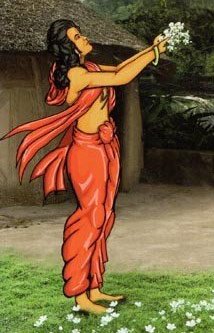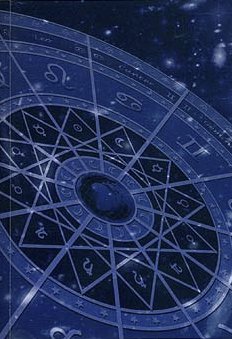Payoshni, Payoṣṇī: 16 definitions
Introduction:
Payoshni means something in Hinduism, Sanskrit. If you want to know the exact meaning, history, etymology or English translation of this term then check out the descriptions on this page. Add your comment or reference to a book if you want to contribute to this summary article.
The Sanskrit term Payoṣṇī can be transliterated into English as Payosni or Payoshni, using the IAST transliteration scheme (?).
In Hinduism
Shaivism (Shaiva philosophy)
Source: Wisdom Library: Kubjikāmata-tantraPayoṣṇī (पयोष्णी, “Warm-watered”):—First of the eight Mātṛs born from the body of Sukṛtālayā, according to the Kubjikāmata-tantra. These eight sub-manifestations (mātṛ) are associated with the (element) water. Payoṣṇī represents the name of a river. They are presided over by the Bhairava Kapālīśa and his consort named Cāmuṇḍā. Sukṛtālayā is the Last of the Eight Mahāmātṛs, residing within the Mātṛcakra (third of the five cakras) and represents water.

Shaiva (शैव, śaiva) or Shaivism (śaivism) represents a tradition of Hinduism worshiping Shiva as the supreme being. Closely related to Shaktism, Shaiva literature includes a range of scriptures, including Tantras, while the root of this tradition may be traced back to the ancient Vedas.
Purana and Itihasa (epic history)
Source: Wisdom Library: Varāha-purāṇaPayoṣṇī (पयोष्णी).—Name of a river originating from Vindhya, a holy mountain (kulaparvata) in Bhārata, according to the Varāhapurāṇa chapter 85. There are settlements (janapada) where Āryas and Mlecchas dwell who drink water from these rivers.
Bhārata is a region south of Hemādri, once ruled over by Bharata (son of Ṛṣabha), whose ancestral lineage can be traced back to Svāyambhuva Manu, who was created by Brahmā, who was in turn created by Nārāyaṇa, the unknowable all-pervasive primordial being.
The Varāhapurāṇa is categorised as a Mahāpurāṇa, and was originally composed of 24,000 metrical verses, possibly originating from before the 10th century. It is composed of two parts and Sūta is the main narrator.
Source: archive.org: Puranic EncyclopediaPayoṣṇī (पयोष्णी).—A holy river. This river starts from the Vindhya mountains and flows to the west. Nala and Damayantī walked through the banks of this river. (Chapter 61, Vana Parva). Those who bathe in this river will get the benefit of doing a thousand godānas (gifts of cows). There is a sacred place on the shores of this river called Varāhatīrtha. King Nṛga performed a Yāga at this place at which Indra came and had Somapāna and the brahmins received dakṣiṇā (fees) and got drunk. (Chapters 88 and 121, Vana Parva). Even the mere contact of water-drops of Payoṣṇī river would absolve one of all sins. The musical instrument Śṛṅga of Śiva is in this river. Dharmaputra once came to this river and stayed there for some time drinking its water. (Chapter 120, Vana Parva). On another occasion Gaya son of King Amūrtarayas conducted seven aśvamedhas at this place and pleased Indra. (Chapter 21, Anuśāsana Parva).
Source: Cologne Digital Sanskrit Dictionaries: The Purana IndexPayoṣṇī (पयोष्णी).—A river from the Ṛkṣa hill in Bhāratavarṣa1 visited by Balarāma;2 sacred to Pingaleśvarī and the Pitṛs.3
- 1) Bhāgavata-purāṇa V. 19. 18; Brahmāṇḍa-purāṇa II. 16. 32; Vāyu-purāṇa 45. 102; Viṣṇu-purāṇa II. 3. 11.
- 2) Bhāgavata-purāṇa X. 79. 20.
- 3) Matsya-purāṇa 13. 44; 22. 33. 64; 114. 27.
Payoṣṇī (पयोष्णी) refers to the name of a River or Tīrtha (pilgrim’s destination) mentioned in the Mahābhārata (cf. III.83.37, III.86.4, VI.10.15, VI.10.19). Note: The Mahābhārata (mentioning Payoṣṇī) is a Sanskrit epic poem consisting of 100,000 ślokas (metrical verses) and is over 2000 years old.

The Purana (पुराण, purāṇas) refers to Sanskrit literature preserving ancient India’s vast cultural history, including historical legends, religious ceremonies, various arts and sciences. The eighteen mahapuranas total over 400,000 shlokas (metrical couplets) and date to at least several centuries BCE.
Kavya (poetry)
Source: Shodhganga: The Kavyamimamsa of RajasekharaPayoṣṇi (पयोष्णि) is the name a locality mentioned in Rājaśekhara’s 10th-century Kāvyamīmāṃsā.—A south Indian River, which may be identified with the Pūrṇā, a tributary to the river Tāpī.

Kavya (काव्य, kavya) refers to Sanskrit poetry, a popular ancient Indian tradition of literature. There have been many Sanskrit poets over the ages, hailing from ancient India and beyond. This topic includes mahakavya, or ‘epic poetry’ and natya, or ‘dramatic poetry’.
Ayurveda (science of life)
Dietetics and Culinary Art (such as household cooking)
Source: Shodhganga: Dietetics and culinary art in ancient and medieval IndiaPayoṣṇī (पयोष्णी) is an important river whose water (jala) qualities are described in the Bhojanakutūhala (dravyaguṇāguṇa-kathana), and is commonly found in literature dealing with the topics of dietetics and culinary art, also known as Pākaśāstra or Pākakalā.—Different types of water (jala) and their properties are mentioned here [viz., in jala-prakaraṇa]. The text explains the qualities of the water of certain important rivers like [viz., Payoṣṇī].

Āyurveda (आयुर्वेद, ayurveda) is a branch of Indian science dealing with medicine, herbalism, taxology, anatomy, surgery, alchemy and related topics. Traditional practice of Āyurveda in ancient India dates back to at least the first millenium BC. Literature is commonly written in Sanskrit using various poetic metres.
Jyotisha (astronomy and astrology)
Source: Wisdom Library: Brihat Samhita by VarahamihiraPayoṣṇī (पयोष्णी) is the name of a River, according to the Bṛhatsaṃhitā (chapter 16) (“On the planets—graha-bhaktiyoga”), an encyclopedic Sanskrit work written by Varāhamihira mainly focusing on the science of ancient Indian astronomy astronomy (Jyotiṣa).—Accordingly, “Mars presides over the people residing in the west half of the countries on both banks of the Śoṇa, the Narmadā and the Beas; over those residing on the banks of the Nirvindhya, the Vetravatī, the Siprā, the Godāvarī, the Veṇa, the Gaṅgā, the Payoṣṇī, the Mahānadī, the Indus, the Mālatī and the Pārā; he also presides over the country of Uttarapāṇḍya, [...]”.

Jyotisha (ज्योतिष, jyotiṣa or jyotish) refers to ‘astronomy’ or “Vedic astrology” and represents the fifth of the six Vedangas (additional sciences to be studied along with the Vedas). Jyotisha concerns itself with the study and prediction of the movements of celestial bodies, in order to calculate the auspicious time for rituals and ceremonies.
Languages of India and abroad
Sanskrit dictionary
Source: DDSA: The practical Sanskrit-English dictionaryPayoṣṇī (पयोष्णी).—Name of a river rising in the Vindhya mountain (identified by some with the modern Tāptī river, but more correctly with Purṇā, a feeder of that river).
Source: Cologne Digital Sanskrit Dictionaries: Shabda-Sagara Sanskrit-English DictionaryPayoṣṇī (पयोष्णी).—f. (-ṣṇī) A river that rises in the Vindhya mountain. The Narmada according to some, the Tapti according to others.
Source: Cologne Digital Sanskrit Dictionaries: Benfey Sanskrit-English DictionaryPayoṣṇī (पयोष्णी).—i. e. an anomal. comp. payas-uṣṇa + ī, f. The name of a river.
Source: Cologne Digital Sanskrit Dictionaries: Cappeller Sanskrit-English DictionaryPayoṣṇī (पयोष्णी).—[feminine] [Name] of a river.
Source: Cologne Digital Sanskrit Dictionaries: Monier-Williams Sanskrit-English DictionaryPayoṣṇī (पयोष्णी):—[from paya] f. ([Mahābhārata; Varāha-mihira; Purāṇa]) Name of a river rising in the Vindhya mountain
Source: Cologne Digital Sanskrit Dictionaries: Yates Sanskrit-English DictionaryPayoṣṇī (पयोष्णी):—(ṣṇī) 3. f. Name of a river.
[Sanskrit to German]
Sanskrit, also spelled संस्कृतम् (saṃskṛtam), is an ancient language of India commonly seen as the grandmother of the Indo-European language family (even English!). Closely allied with Prakrit and Pali, Sanskrit is more exhaustive in both grammar and terms and has the most extensive collection of literature in the world, greatly surpassing its sister-languages Greek and Latin.
See also (Relevant definitions)
Starts with: Payoshnijata, Payoshnika.
Ends with: Payahpayoshni.
Full-text: Payoshnijata, Payahpayoshni, Payoshnika, Pingaleshvari, Kacchapa, Maha-Magha, Malati, Bhimaratha, Pashcimardha, Godavari, Nirvindhya, Mahanadi, Para, Vetravati, Shipra, Mandakini, Uttarapandya, Sukritalaya, Vimishra.
Relevant text
Search found 20 books and stories containing Payoshni, Payoṣṇī, Payosni; (plurals include: Payoshnis, Payoṣṇīs, Payosnis). You can also click to the full overview containing English textual excerpts. Below are direct links for the most relevant articles:
Mahabharata (English) (by Kisari Mohan Ganguli)
Chaitanya Bhagavata (by Bhumipati Dāsa)
Verse 1.9.150 < [Chapter 9 - Nityānanda’s Childhood Pastimes and Travels to Holy Places]
Verse 3.2.308 < [Chapter 2 - Description of the Lord’s Travel Through Bhuvaneśvara and Other Placesto Jagannātha Purī]
Rivers in Ancient India (study) (by Archana Sarma)
11. Descriptions of the rivers in the Jambudvīpa < [Chapter 5 - Rivers in the Purāṇic Literature]
3c. The sacred aspect of the river Sarasvatī < [Chapter 5 - Rivers in the Purāṇic Literature]
10. Various other rivers in the Purāṇas < [Chapter 5 - Rivers in the Purāṇic Literature]
The Garuda Purana (by Manmatha Nath Dutt)
Chapter LV - Description of the Geographical situations of the different countries of the earth < [Agastya Samhita]
Chapter LXXXI - A brief description of holy pools and sanctuaries < [Agastya Samhita]
List of Mahabharata people and places (by Laxman Burdak)
The Padma Purana (by N.A. Deshpande)
Chapter 6 - Bhāratavarṣa: Its Rivers and Regions < [Section 3 - Svarga-khaṇḍa (section on the heavens)]
Chapter 11 - A list of sacred places (tīrtha) < [Section 1 - Sṛṣṭi-khaṇḍa (section on creation)]
One hundred and eight (108) names of Sāvitrī < [Section 1 - Sṛṣṭi-khaṇḍa (section on creation)]